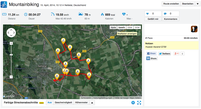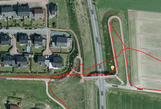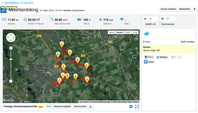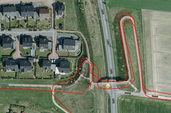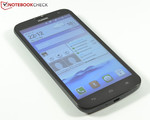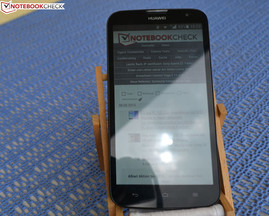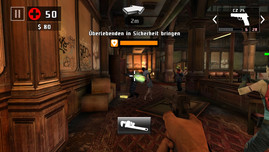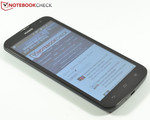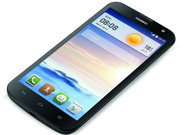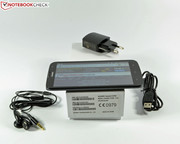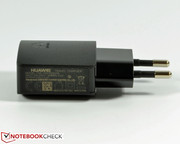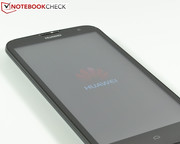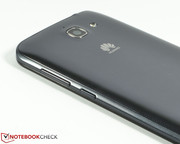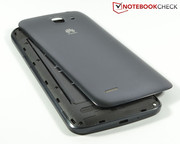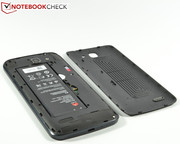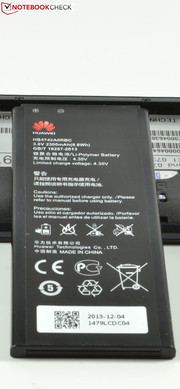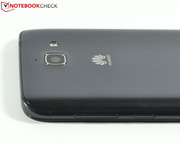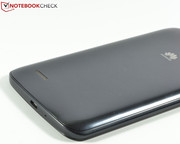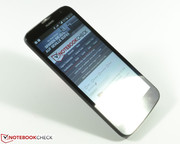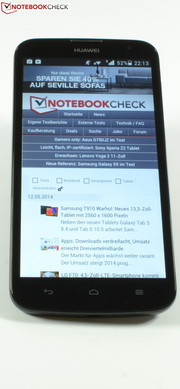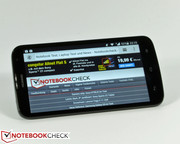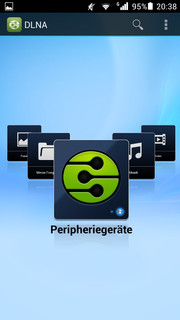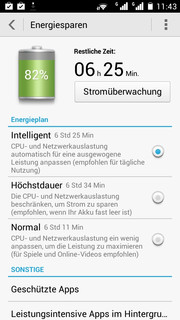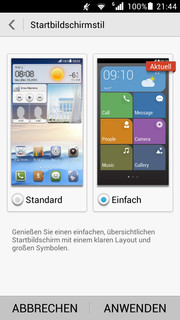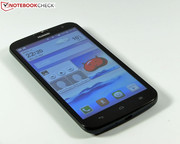Huawei Ascend G730 Smartphone Review
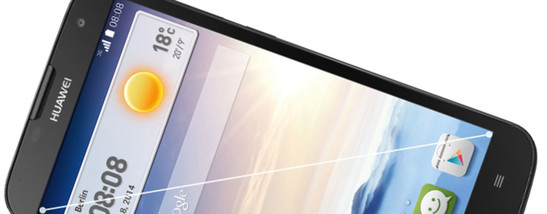
For the original German review, see here.
Huawei has recently contributed a number of new smartphones to the mobile market: The company advertises a whole seven distinct models on their website. However, the exact differences between the various series are a bit of a mystery to us -- the website is too unclear about how the devices are classified. We said the same thing in our recently published review of the Huawei Ascend G610. However, in terms of color choices the selection is clear: Most of the smartphones are available in black or white.
The Chinese company includes a few so-called dual-SIM smartphones in their lineup, i.e. devices that offer two SIM card slots. Our test device, the Huawei G730-U10, belongs to this unfortunately still very underrepresented category here in Germany. Huawei is using this opportunity to claim their part in the "smartphone evolution." Looking over the phablet's specs, including a 5.5-inch display with qHD resolution, a MediaTek 1.3 GHz quadcore SoC, 1 GB RAM, 4 GB flash storage, a 5-megapixel main camera and, of course, the dual-SIM feature, the smartphone classifies as a mid-class device. This is a highly competitive segment of the mobile market, so our test device has to contend with a huge variety of competitors, including the Alcatel One Touch Pop C7, the LG G Pro Lite Dual D686 and the Acer Liquid S1.
When it comes to the Ascend G730's case, there is next to nothing to complain about. We freely admit, of course, that there is nothing remarkable about the smartphone's design, nor do its materials give it a great feel or a high degree of grip. But on the plus side, it stands up to pressure incredibly well, and its manufacturing quality is very good.
"Compact" is, of course, not really a word you can use to describe this device, but if you are looking at a 5.5-incher, that most assuredly is not a characteristic on your wish list. At a thickness of 9.6 mm (~0.38 inches), the Ascend G730 could be a little thinner, but it can easily compete with other phablets on the market.
Connectivity
The Huawei Ascend G730-U10's hardware features are standard for phablets in this price class. The device runs on a quad-core MediaTek MT6582 SoC with a clock frequency of 1.3 GHz, supported by an integrated Mali 400MP2 GPU and 1 GB of RAM. While the working memory is sufficient for most applications, the flash storage quickly fills up -- especially given that out of the 4 GB of net storage, only 2 GB remains available to the user. However, you can use a microSD card to expand the storage space by up to 64 GB (32 GB according to Huawei). The micro USB 2.0 port on the bottom side of the device doubles as both a recharge port and a connection for data transfer between the smartphone and a PC. The Android keys are touch fields underneath the display frame, meaning they do not cut into the display area. Huawei positioned a volume rocker and a power button on the right side of the device.
Software
Android 4.2.2 Jelly Bean acts as the Huawei Ascend G730's operating system. As of right now, the company has not announced an upgrade to Android's current OS (Android 4.4 KitKat).
As usual, Huawei overlaid the Android user interface with their proprietary EmotionUI interface (version 2.0). This makes the interface somewhat easier to navigate.
Communication & GPS
The Huawei Ascend G730 supports tri-band GSM (900, 1800, 1900 MHz) in both SIM slots. Only the first SIM slot also supports UMTS (900, 2100 MHz). The device also supports the WLAN standards 802.11 b/g/n on the 2.4 GHz band. The module's reception range is respectable -- even when the device is relatively distant from the router, it is possible for the reception to remain stable. Bluetooth 4.0 and DNLA are also on board.
The GPS module works reliably and is able to connect to a number of satellites, even indoors. In our practical test, which involves navigation along an 11 km-long (~6.8 miles) route on a mountain bike, our review device did a satisfactory job of recording our position. Along more difficult sections with lots of curves, the smartphone's log deviates significantly from that of our Garmin Edge 500, but overall the G730 can certainly lend a helping hand with navigation.
Phone Function & Speech Quality
The dual-SIM manager is well-integrated into the system and intuitive to use. The number keys in the phone app are big enough to make it easy to hit the right key every time. In portrait mode, when the one-handed operation user interface is activated, the keys do not fill the whole width of the display. An arrow pushes the number block either to the right or to the left side to make the keys easier to reach with one hand.
It baffles us as to why Huawei decided to make the first SIM slot for normal-sized SIM cards, but the second slot for micro SIM cards. One must assume that the manufacturer skimped to save money, but the result is that only slot 1 supports 3G.
The speech and audio quality could be a little less tinny, but it is always clearly understandable. The smartphone did not appear to cancel out environmental noise during our test.
Cameras & Multimedia
With its 0.3 MP resolution, the phablet's front camera is only sufficient for the occasional video chat. There can be no jumping on the selfie-trend bandwagon here. The main camera has a reasonably high resolution of 5 MP and an LED flash. Even so, the camera is only good for snapshots in favorable lighting conditions. Photo enthusiasts will bemoan the lack of depth of focus and relatively high level of image noise in poor lighting environments. Dark areas are somewhat flooded and swallow up details.
Accessories
Besides the smartphone itself and its replaceable battery, Huawei also includes a modular charging device with a USB cable and a stereo headset in the G730's packaging. As of right now, no device-specific optional accessories are available.
Warranty
Huawei outfits their smartphone with a 24-month warranty, while the battery is only covered for six months. The manufacturer does not offer any other options.
Input Devices & Operation
The 5.5-inch touchscreen registers input reliably and with precision. Its reactions are sometimes only very briefly delayed. However, the display surface could be more conducive to easy gliding.
We addressed the advantages and disadvantages of the Emotion UI keyboard at length in our recent review of the Huawei Ascend G610. Like in the phone app, when the one-handed operation UI is activated in portrait mode, the keyboard does not take up the whole width of the display.
Display
Despite its low price, Huawei outfits their Ascend G730 with a big 5.5-inch IPS display -- which means good color reproduction and a high degree of viewing-angle stability are guaranteed. The panel's resolution of 960x540 pixels is appropriate for this price class. However, the somewhat larger and about 50 Euros (~$70) more expensive Acer Liquid S1 already offers HD resolution. Still, subjectively our test device's image content appears very sharp.
At an average of 521.7 cd/m², the Huawei device's brightness level is very high. Its brightness distribution is only 85% similar across the screen, which is more or less average for its class. Competitors like the Alcatel One Touch Pop C7 and the Acer Liquid S1 are marginally more evenly lit, but they cannot hold a candle to the G730's brightness.
| |||||||||||||||||||||||||
Brightness Distribution: 85 %
Center on Battery: 565 cd/m²
Contrast: 796:1 (Black: 0.71 cd/m²)
ΔE Color 6.47 | 0.5-29.43 Ø5
ΔE Greyscale 6.02 | 0.57-98 Ø5.3
Gamma: 2.28
Our test device's black value of 0.71 cd/m² is somewhat high, but its contrast ratio of 796:1 is good. Even so, its competitors can do a little better. Nevertheless, subjectively the G730's image sharpness and black representation are of a high caliber.
Our tests using the CalMAN software and an X-Rite i1pro2 colorimeter revealed that the display's color temperature is somewhat too cool. Also, greens and yellows deviate significantly from their ideal values. At 6.47, the average DeltaE deviation for mixed colors is just too high. Especially along the lighter part of the grayscale, the values stray too far from the ideal, and the scale is shrouded in a faint green cast. Subjectively, however, this only plays a minor role, especially considering the G730's moderate price.
At a maximum brightness of 565 cd/m², the G730 is very well-suited for outdoor use. Of course, the glass display surface is very reflective, which makes it much more difficult to see the screen content under direct sunlight.
In terms of viewing-angle stability, with its IPS display, the Huawei Ascend G730 can hold its own: Even from extreme angles, the display's colors always remain stable; only the brightness loses a bit of its luster. As is typical of IPS panels, there is a bit of a glow effect, but only on darker, monochromatic images at wider viewing angles.
Performance
The Huawei Ascend G730's performance is standard for a mid-class device. The smartphone is equipped with a MediaTek MT6582 quad-core SoC with a clock rate of 1.3 GHz. This processor offers enough performance for almost every kind of task.
In our battery of synthetic benchmarks, the G730's performance is solid. The competitors with weaker hardware, i.e. the Alcatel One Touch Pop C7 and the LG G Pro Lite Dual D686, cannot quite keep up here -- only the Acer Liquid S1, with its stronger CPU, comes in just ahead of our test device.
| Geekbench 3 | |
| 32 Bit Multi-Core Score (sort by value) | |
| Huawei Ascend G730 | |
| Alcatel One Touch Pop C7 | |
| Acer Liquid S1 | |
| LG Optimus G Pro Lite Dual D686 | |
| 32 Bit Single-Core Score (sort by value) | |
| Huawei Ascend G730 | |
| Alcatel One Touch Pop C7 | |
| Acer Liquid S1 | |
| LG Optimus G Pro Lite Dual D686 | |
| AnTuTu v4 - Total Score (sort by value) | |
| Huawei Ascend G730 | |
| Alcatel One Touch Pop C7 | |
| Acer Liquid S1 | |
| Acer Liquid S1 | |
| LG Optimus G Pro Lite Dual D686 | |
| PassMark PerformanceTest Mobile V1 - System (sort by value) | |
| Huawei Ascend G730 | |
| Alcatel One Touch Pop C7 | |
| Acer Liquid S1 | |
| LG Optimus G Pro Lite Dual D686 | |
| GFXBench (DX / GLBenchmark) 2.7 | |
| 1920x1080 T-Rex Offscreen (sort by value) | |
| Huawei Ascend G730 | |
| Acer Liquid S1 | |
| T-Rex Onscreen (sort by value) | |
| Huawei Ascend G730 | |
| Acer Liquid S1 | |
| 3DMark | |
| 1920x1080 Ice Storm Extreme Physics (sort by value) | |
| Huawei Ascend G730 | |
| Alcatel One Touch Pop C7 | |
| Acer Liquid S1 | |
| 1920x1080 Ice Storm Extreme Graphics (sort by value) | |
| Huawei Ascend G730 | |
| Alcatel One Touch Pop C7 | |
| Acer Liquid S1 | |
| 1920x1080 Ice Storm Extreme Score (sort by value) | |
| Huawei Ascend G730 | |
| Alcatel One Touch Pop C7 | |
| Acer Liquid S1 | |
| 1280x720 offscreen Ice Storm Unlimited Score (sort by value) | |
| Huawei Ascend G730 | |
| Acer Liquid S1 | |
| LG Optimus G Pro Lite Dual D686 | |
This favorable picture changes in the browser-based benchmarks. In almost every test, our G730 falls behind every competitor. In the AndroBench 3 internal storage test, too, our test device does not have much to be proud of. But subjectively, the Huawei Ascend G730 runs at a satisfactory speed in every discipline.
| Mozilla Kraken 1.1 - Total (sort by value) | |
| Huawei Ascend G730 | |
| Alcatel One Touch Pop C7 | |
| Acer Liquid S1 | |
| LG Optimus G Pro Lite Dual D686 | |
| Octane V2 - Total Score (sort by value) | |
| Huawei Ascend G730 | |
| Alcatel One Touch Pop C7 | |
| LG Optimus G Pro Lite Dual D686 | |
| Sunspider - 1.0 Total Score (sort by value) | |
| Huawei Ascend G730 | |
| Acer Liquid S1 | |
| LG Optimus G Pro Lite Dual D686 | |
| Peacekeeper - --- (sort by value) | |
| Huawei Ascend G730 | |
| Acer Liquid S1 | |
| LG Optimus G Pro Lite Dual D686 | |
* ... smaller is better
Games
The G730 offers strong enough performance for most current games -- and they are a lot of fun on the big 5.5-inch touchscreen. Thanks to the quick reactions from the touchscreen and the position sensor, the user always has good control over the goings-on within the game. Titles that demand more of the hardware only run fluidly if the detail level is set to low.
Emissions
Temperature
Because the SoC installed in the smartphone does not have a very high clock frequency and thus produces little heat, and because the large case allows for effective cooling, the Huawei Ascend G730's surface temperatures always remain comfortable. Even under full load, at an average of about 33 °C (91.4 °F), the case barely heats up at all and only grows faintly warm in a few spots. The power supply is the only exception: Under load, it becomes rather warm and ought to be placed in an open area.
(+) The maximum temperature on the upper side is 37.8 °C / 100 F, compared to the average of 35 °C / 95 F, ranging from 21.9 to 56 °C for the class Smartphone.
(+) The bottom heats up to a maximum of 37.5 °C / 100 F, compared to the average of 33.8 °C / 93 F
(+) In idle usage, the average temperature for the upper side is 27 °C / 81 F, compared to the device average of 32.7 °C / 91 F.
Speakers
A single speaker on the backside of a device will, of course, have a hard time generating a good sound. As a result, we deem the Huawei Ascend G730's sound to be alright. The sound is dominated by high tones, bass is lacking and mid-tones are subdued. Additionally, the speaker is often partially covered by your hand or a tabletop. Hence our lukewarm feelings on the subject.
Energy Management
Power Consumption
Compared to other devices in its class, the Huawei Ascend G730's power consumption is a little too high. Granted, at a maximum power usage of 2.1 Watts in standby and idle mode, our test device keeps itself in check. But under full load, the smartphone consumes a full 5.8 to 6.8 Watts. Even the bigger Acer Liquid S1 with better performance is more of a conservationist here.
| Off / Standby | |
| Idle | |
| Load |
|
Battery Life
Even with its high energy consumption, with its 8.8 Wh battery, the G730 did surprisingly well in our battery life tests. This is especially clear when we compare the phablet with the other devices in its class.
In almost every test, our review device takes the lead over its competitors. Only in our surf test over WLAN, which we run with the display brightness set to 150 cd/m², does the LG G Pro Lite Dual D686 get ahead -- though it has a considerably stronger battery as well as more energy-efficient hardware.
Under full load, our smartphone runs for a good 4 hours. That puts it on par with its competitors, like the Acer Liquid S1. The Huawei Ascend G730 keeps chugging along for a maximum of a whole 18 hours away from the charger -- even the Alcatel One Touch Pop C7 with its fatter battery cannot keep up with a number like that.
Verdict
So, can we in good conscience recommend the Huawei Ascend G730? Let us weigh the positive against the negative.
To the smartphone's credit, it has a bright, contrast-rich IPS display and a good battery life. It also deserves points for its respectable application performance and gaming performance, and we ought to also mention its main camera, which does quite well in good lighting conditions.
We are less fond of the lousy speaker, the crummy front camera and the very hard-to-remove battery lid. Additionally, we cannot understand why the two SIM card slots are not the same size, or why only one supports 3G. Neither can we quite get over the fact that the smartphone's Android OS is no longer up-to-date.
But all in all, this is a good phablet, and it is currently available for a low 230 Euros (~$315). The problem is that there are most interesting alternatives. If you do not need the dual-SIM capability, the competition continues to grow, and we recommend perusing the rest of the market before making a decision.


 Deutsch
Deutsch English
English Español
Español Français
Français Italiano
Italiano Nederlands
Nederlands Polski
Polski Português
Português Русский
Русский Türkçe
Türkçe Svenska
Svenska Chinese
Chinese Magyar
Magyar







